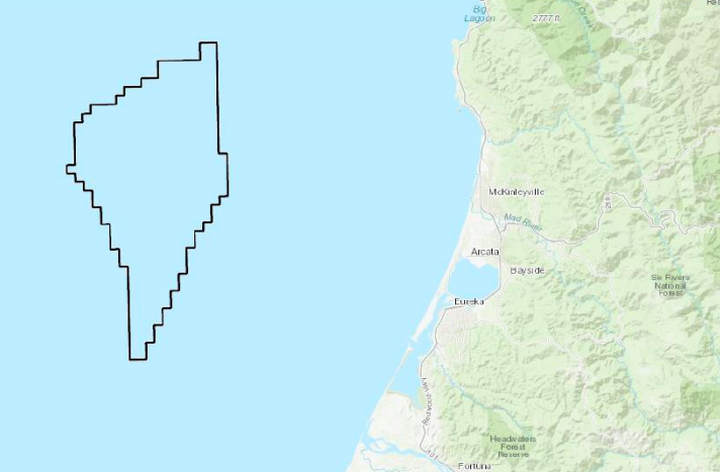The proposed offshore wind project site, known as the Humboldt Wind Energy Area, would be located approximately 21 miles west of Eureka. | Coastal Commission
###
The California Coastal Commission removed a critical hurdle this Thursday to allow for further exploration of a proposed wind energy project just off of Humboldt County’s coast.
In a unanimous decision, the commission voted to conditionally concur that a consistency determination brought forth by the Bureau of Ocean Energy Management (BOEM) for leasing activities associated with the proposed project adheres to the California Coastal Management Program.
In essence, the wordy and convoluted decision allows BOEM to initiate talks with interested energy companies and begin assessments of the proposed project site, known as the Humboldt Wind Energy Area (WEA), which would span over 132,000 acres approximately 21 miles west of Eureka.
As outlined in the 133-page staff report, BOEM plans to issue up to three federal leases that would “allow lessees to perform geophysical, geotechnical, and biological surveys and would permit site assessment activities…” Once the surveys and site assessments are completed, the lessees will submit a construction and operations plan which would trigger a federal environmental review process and would require the lessees to receive consistency certifications from the commission before any development can be approved by BOEM.
The push to develop offshore wind energy resources in California is a part of the Biden administration’s plan to deploy 30 gigawatts of offshore wind power by 2030 and a part of the state’s goal to achieve carbon neutrality no later than 2045.
“We are in the midst of a climate crisis,” Dr. Kate Huckelbridge, senior deputy director at the Coastal Commission, said during Thursday’s meeting. “We deal with the effects on our coastline every day. To contain the crisis, California has set very ambitious goals to convert the state’s electric grid to run fully on renewable energy. …It is critical that we understand what [potential] trade-offs are and that we proceed with all necessary caution to ensure that offshore wind facilities are designed and operated in a manner that is protective of our invaluable coastal and ocean resources.”
Huckelbridge identified 10 primary areas of concern for the project including commercial and recreational fishing, marine resources and water quality, oil spills, coastal hazards, scenic and visual resources, public access and recreation, tribal and cultural resources, environmental justice, air quality and fill of coastal waters.
Staff recommended several conditions to minimize the impacts on these areas. (Those conditions can be found here.)
BOEM Pacific Regional Supervisor Doug Borem noted that the organization has developed national guidelines for offshore wind energy projects and underscored BOEM’s commitment to environmental protection.
“The [construction and operations plan] must demonstrate that it does not unreasonably interfere with other uses of the [outer continental shelf] including national security,” he said. “It does not cause undue harm or damage to natural resources, life, property and marine, coastal or human environment.”
He added that lessees are required to submit a consistency certification as part of the operations plan and must achieve a concurrence before the plan can be finalized.
Kourtney Vaccaro, chief counsel of the California Energy Commission (CEC), emphasized that the proposed project plays an essential role in achieving the state’s goal to reach carbon neutrality by 2045.
“We see that building offshore wind is poised to play an important part of the future portfolio for renewable and zero-emission technologies for California and also globally,” she said. “…As the [staff] report makes clear, we also need to be strategic and thoughtful once we pursue floating offshore wind energy and that it’s really important that we protect ocean and coastal resources.”
Speaking on behalf of Humboldt Bay Harbor, Recreation and Conservation District Executive Director Larry Oetker, Robert Holmlund, director of development for the district, noted that the district is actively working to revamp the port and redevelop Redwood Marine Terminal I.
“Humboldt Bay is really well positioned to be the location at which the wind turbines would be manufactured and assembled,” he said. “…The [CEC] has granted nearly $11 million to the district to begin the permitting, design and construction of a new terminal here.”
Holmlund added that the district has begun conversations with fishermen, tribal governments and environmental groups to identify potential issues associated with the development of the Port of Humboldt and the proposed offshore wind project.
North Coast fishermen dominated the public comment segment of Thursday’s discussion. Ken Bates, vice-president of the Humboldt Fisherman’s Marketing Association, stressed that his organization is not opposed to renewable energy but said, “fishermen are opposed to the industrialization [and] loss of California’s fishing grounds.”
Bates asked the commission to consider three requests as project assessments move forward. He requested that “nothing be [abandoned] on the fishing grounds during survey work, implementation or decommissioning of the project,” that the developers fund a fisheries liaison officer that will be selected by the commercial fishermen’s associations and that associated agencies adopt community-benefit agreements that were submitted to the commission from fishermen’s associations across the state.
Several other fishermen raised concern about how transmission lines stretching from the wind turbines to the shore will impact crab fishermen. Others worried about how U.S. Coast Guard rescue operations would be impacted by the project.
Michael Conroy, executive director of the Pacific Coast Federation of Fishermen’s Associations, aired similar concerns and pointed to recent news that a wind energy company violated the Migratory Bird Treaty Act and had been sentenced and fined after its wind turbines killed more than 150 eagles in eight states over the last decade.
“Given that the Humboldt Energy Area is habitat for a number of endangered species, including the short-tailed Albatross, we should move forward responsibly if at all,” he said.
Several others spoke in favor of the project. A couple of trade association representatives noted that the project would create jobs across the state. A handful of environmentalists said the project would help mitigate the impacts of climate change but urged commissioners to proceed with caution.
“The future of offshore wind energy offers us the opportunity to fight climate change, but it must be done responsibly,” said Tom Wheeler, executive director of the Environmental Protection Information Center (EPIC). “EPIC strongly supports the staff report’s overarching approach to looking at offshore wind development holistically and we support the conditions put forth in the staff report.”
Like Wheeler, Humboldt Baykeeper Director Jennifer Kalt expressed optimism for the future of offshore wind energy in California but said she was concerned about potential impacts to sensitive, rare or vulnerable fish species.
The commission expressed general support for the offshore wind energy project and agreed with the additional conditions that had been put forward by staff.
Commissioner and Third District Humboldt County Supervisor Mike Wilson said the subject of wind energy “has been a big subject in my community for a long time,” referring to the highly contentious Terra-Gen wind energy project that was the Board of Supervisors in 2019.
“We had a wind energy project in 2019 that was a big deal in our community and it was denied,” he said. “…This is meaningful to us. This is a really big deal. It’s being talked about on a national scale but really we’re this tiny island and that has a real impact on us, and we have an impact on it.”
The Humboldt County community is leaning into the global fight against climate change “but our feet are firmly planted in our in our advocacy for our community,” he added. “…As a community, no one’s gonna roll over on this.”
Huckelbridge noted that staff’s decision to add the aforementioned conditions to the report was made with the Humboldt County community in mind and echoed Wilson’s call to move forward thoughtfully. “It’s important to provide resources to those communities so that they can come to those conversations in full and that was part of the impetus behind these changes,” she said.
Commissioner Meagan Harmon said the commission’s decision “could be transformational.”
“It’s rare in my experience to have the opportunity to vote on something that has the possibility of being so transformational,” she said. “I don’t think it’s hyperbole to say that we are really taking a vote today that’s beginning the process of something that could be transformational for our state and really more broadly than that.”
Wilson made a motion to approve staff’s recommendation after additional discussion and asked the commission for a “yes” vote. Commissioner Sara Aminzadeh seconded the motion.
Before taking a roll call vote Wilson reiterated that Humboldt is a “community that expects engagement.”
The motion passed unanimously.
Humboldt Bay Trail
The commission also considered – and ultimately approved – a permit application from the County of Humboldt to expand the Humboldt Bay Trail by 4.25 miles and complete the connection between Eureka and Arcata.
Melissa Kraemer, a supervising analyst for the commission, noted that the trail expansion “has been a really challenging project with many complications and evolving issues over a number of years.”
Staff has faced challenges with the rail line as significant portions of the trail run within the railroad right-of-way. Although the rail line is technically considered active, it has not seen traffic for over 25 years.
There have also been challenges with billboards, sea-level rise, an easement acquisition from California Redwood Company, a subsidiary of Green Diamond Resource Company, and eucalyptus trees, she said. The project includes the removal of approximately 200 eucalyptus trees between the proposed trail and the highway.
“We appreciate the hard work on this project and its collaboration with [the commission], especially in providing all the various pieces of information that we’ve requested during our permit review,” Kraemer said.
Hank Seemann, deputy director of environmental services for Humboldt County, reminded the commission that the project had been in the works for decades.
“This is a really important project for the Humboldt Bay region,” he told the commission. “For over 20 years, there’s been a vision for having a separated paved path between Eureka and Arcata for non-motorized travel. Separation from vehicles is really the key to safety and the community feeling comfortable.”
Seemann added that the county “is ready to accept conditions recommended by staff” to move forward with the permit.
Several members of the Humboldt Trails Council urged the commission to approve the permit request during public comment.
“Our county is filled with active trail users who have literally waited over 20 years for this portion of the Bay Trail to be completed,” said Humboldt Trails Council board member Karen Underwood. “…A completed Bay Trail will offer not only a safe transportation option but an outstanding recreational opportunity with dramatic views of the bay as another beautiful draw to tourists.”
Another board member, Korina Johnson, added that the trail extension will, hopefully, encourage more folks to ride bikes rather than drive.
Wilson acknowledged that “we still have a pretty long way to go” on the project but expressed enthusiasm for its future.
“It was said if we railbanked and just built the trail, this would cost $5 million and take five years and if we did not rail bank it would take…$20 million and take 15 years and that was a planning report that was absolutely correct,” he said. “…We as a community have invested over $15 million into that rail project.”
After a few additional comments from commissioners, Wilson made a motion to approve the permit application with conditions. The motion was seconded by Commissioner Dayna Bochco and unanimously approved.



CLICK TO MANAGE